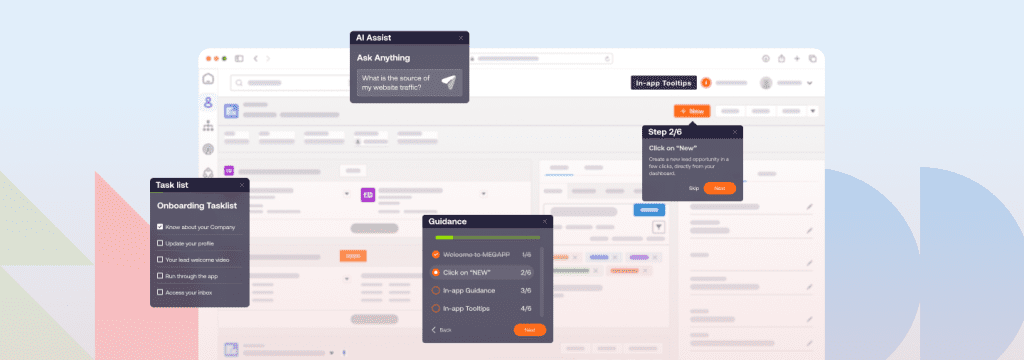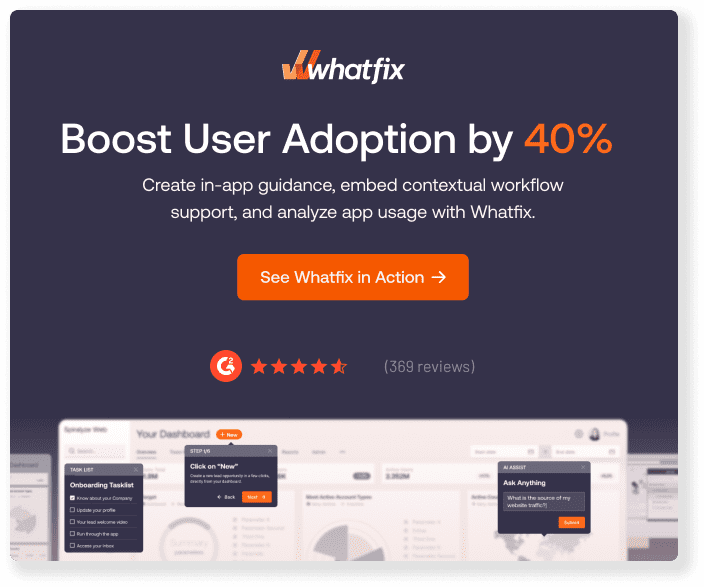As businesses continue to shift toward more immersive, hands-on approaches to training, those that stay ahead of the curve are seeing incredible benefits. Studies show that the use of simulated experiences for training can improve knowledge retention by over 50%, leading to accelerated onboarding, faster skill development, more confident employees, fewer mistakes, and substantial improvements in overall performance.
As the excitement around AI-powered simulation training grows, L&D software companies are developing new technologies that enable team members to engage with realistic scenarios, both online and offline. Simulated training software, such as Whatfix Mirror, utilizes advanced AI features to replicate live software environments and realistic workplace scenarios, enabling risk-free application exploration and roleplay experimentation.
With these platforms, L&D teams can empower employees to learn by doing, internalize knowledge quickly, and retain what they’ve learned for more powerful learning experiences. AI roleplay and scenario training software has the power to reshape the landscape of workplace learning and empower employees to reach new heights.
In this article, we will examine the impact of scenario-based learning methods and their numerous applications. Then we’ll delve into how AI can supercharge these tools and explore some of the best AI-powered scenario training applications available today.
The Effectiveness of Scenario-Based Learning
70% of workplace learning comes from on-the-job training and hands-on experiences. This makes training activities that replicate realistic work scenarios valuable for learning and development (L&D) teams. Activities like role-playing scenarios and trial-and-error task practice are commonly used in workplace training courses to help employees process and practice what they’ve learned in a safe environment ahead of real-life work situations.
Application sandbox tools, such as Whatfix Mirror, expand the possibilities for scenario training. This technology enables L&D teams to effectively clone software applications, replacing sensitive, live data with placeholders, allowing learners to experiment with different features and practice new workflows without risk. Scenario-based learning is effective because it empowers employees to engage in trial and error, thereby neutralizing performance anxiety and eliminating the potential for negative repercussions when mistakes are made.
With AI, sellers, service agents, and other customer-facing teams are empowered with immersive roleplaying scenarios that adapt to user inputs, role, and skillsets, providing contextual training that helps employees develop specific skills, from soft skills (from leadership, negotiation, and conflict resolution) to role-specific skills (like closing deals, quickly resolving support issues, and building product knowledge).
When these activities are incorporated into software end-user training, it helps employees learn more thoroughly, ultimately improving performance and boosting the ROI of the company’s entire tech stack. Emerging studies are showing increased knowledge retention by 50 to 75%, and growth in knowledge retention by 50% the value of these tools cannot be ignored.
In summary, key benefits of scenario training include:
- Enables L&D leaders to assess competencies, helping them adapt learning activities that empower employees to develop on-the-fly decision-making and problem-solving skills.
- Provides hands-on training in a risk-free setting, accelerating time-to-proficiency and building user confidence.
- Enhances learner engagement, which fosters knowledge retention and improves training completion rates. It also encourages experimentation that can keep employees engaged and excited to hone their skills beyond the basic requirements.
- Protects the organizational reputation by providing customer experience agents with the space and resources they need to practice workflows, exercise soft skills, and ultimately deliver better customer service and support.
Use Cases for AI Scenario Training
Leading L&D companies like Whatfix have developed powerful new AI features that make it easy to create highly relevant and interactive roleplay scenarios within application sandboxes and AI assessments that evaluate employee performance, gauge user readiness for real-world scenarios, and builds user confidence.
Here are some example AI scenarios L&D teams can create with this exciting new technology:
Call Center Agents & Support Teams
- Practice interacting with upset customers
- Resolving conflicts and descalating issues.
- Navigating knowledge bases to find answers to common questions quickly.
- Escalating different types of inquiries and resolving technical issues.
Insurance Providers
- Handling conflict resolution for denied claims
- Practice processing, denying, approving claims
- Managing large-scale coverage for catastrophe claims during disasters
Healthcare Providers
- Practicing clinical skills
- Learning how to de-escalate patients in emergencies
- Triaging different injuries
- Resolving conflicts with disruptive patients
- Fielding patient calls for billing issues
- Reinforcing HIPPA and other healthcare compliance
Sales Teams
- Handling different FAQs by prospects
- AI sales coaching to improve negotiation skills and deal closing.
- Reinforcing product knowledge training with hands-on experiences.
- Practicing objection handling.
HR Teams
- Resolving conflicts between employees
- Practicing leadership skills for executives
- Handling liabilities for HR leaders
- Having career conversations with different types of employees
- Delivering difficult news
The Role of AI in Simulation-Based Roleplay & Scenario Training
AI refers to the ability of a digital system to perform tasks that have historically required human intelligence, such as decision-making, problem-solving, and understanding language. AI revolutionizes L&D by integrating with learning platforms and other training software to personalize learning experiences, provide round-the-clock support, and build interactive immersion training activities.
Here are some ways AI boosts the effectiveness of hands-on scenario training:
- Generating Contextual Situations Based on Institutional Knowledge and Data: By training in-app AI tools on relevant institutional knowledge and data, L&D teams and mangers can easily build training scenarios feel truly relevant as learners interact with them. This keeps employees engaged and ensures that what they learn from training can be directly and immediately applied to real-life situations.
- Adapting Scenarios to End-Users: AI adapts to the ways that users engage with a system, so when learners perform tasks a certain way or make certain mistakes, it automatically customizes the scenario or environment to the correct level of difficulty, reroute training to reinforce topics that need more practice, or continue coming up with new ways to test and prepare employees for their roles.
- AI Assessments: Incorporating AI into immersive training tools makes it easy for L&D teams to provide interactive assessments at the end of scenario-based training activities to help L&D teams gather data and insights on user readiness, benchmark competencies.
- Capture Data to Influence New Training: With the power of AI, L&D tools facilitate the process of using assessment results and user behavior data to not only identify trends and personalize training content, but deliver insights that help trainers focus on key upskilling areas.
Best AI-Powered Scenario & Roleplaying Software
Among AI-powered training tools, Whatfix Mirror stands apart for its ability to replicate real applications and simulate roleplaying exercises in a secure, immersive training environment. Unlike surface-level scenario builders, Mirror creates deep, application-level simulations that give learners meaningful, hands-on practice without risk to production systems.

With Mirror, organizations can:
- Train Safely With Sandbox Environments and Replica Workflows: Easily create interactive, hands-on replicas of any web application, without engineering dependencies. Learners can rehearse real workflows in a controlled environment, reducing costly mistakes and accelerating skill-building.
- Prepare Teams With AI Roleplay: Simulate real-world interactions with AI Roleplay. Employees practice conversations, refine decision-making, and build confidence before engaging with customers or handling high-stakes scenarios—all within a risk-free setting.
- Reinforce Learning With Guided Experiences: Deliver in-app guidance inside your sandbox environments. Mirror provides contextual, step-by-step support during training, ensuring learners build muscle memory, retain knowledge, and onboard faster.
- Analyze User Proficiency With Adaptive Assessments: Validate readiness with interactive, role-based assessments. Mirror measures proficiency and knowledge retention, helping teams demonstrate new competencies through adaptive evaluations tailored to each role.
Why Mirror Works for AI Roleplay and Scenario Training
Mirror doesn’t just replicate software; it replicates the learning experience itself. Its AI-driven roleplay ensures that learners aren’t limited to scripted training paths. Instead, they engage with dynamic scenarios where the AI plays a role, such as mentor, customer, or colleague, responding in context and offering feedback.
This approach mirrors the principles of effective role-play prompts:
- AI understands its role in the scenario, setting context and tone.
- Learners gain agency by choosing and shaping scenarios.
- Training unfolds as an evolving narrative with clear objectives and consequential decisions.
- Post-scenario, AI delivers feedback, reinforcing lessons and guiding reflection.

By combining sandbox environments with adaptive role-play and guided experiences, Whatfix Mirror transforms training into a safe, engaging, and measurable process, helping enterprise L&D teams reduce training costs, minimize errors, and accelerate user proficiency at scale.
Ready to learn more? Request a demo today!








